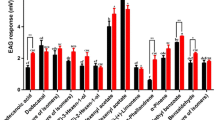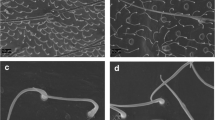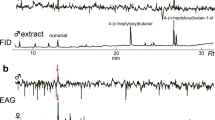Abstract
FemaleMicroplitis croceipes wasps were tested in a wind tunnel for their ability to orient to various concentrations of eight different green leaf volatile (GLV) substances [hexanal, (E)-2-hexenal, (E)-2-hexen-1-ol, (Z)-3-hexen-1-ol, (E)-2-hexenyl acetate, (Z)-3-hexenyl acetate, (Z)-3-hexenyl propionate, and (Z)-3-hexenyl butyrate]. Overall, the esters elicited the greatest percentage of successful orientation flights, the alcohols elicited an intermediate response, and the aldehydes elicited a low response. The semilog dose-response curves were generally hill-shaped with high responses at medium release rates and low responses at high or low release rates. For the aldehydes, positive responses occurred at all GLV release rates between 0.01 and 100 nl/min. For some alcohols and esters, positive responses occurred at release rates as low as 1 pl/min and as high as 1μl/min. These data show thatM. croceipes wasps are strongly attracted to GLVs and are capable of orienting to GLV concentrations that would occur in nature when a caterpillar feeds on a green leaf. Hence, in nature, GLVs may be important clues, enablingM. croceipes to locate their hosts.
Similar content being viewed by others
References
Burton, R.L. 1969. Mass rearing the corn earworm in the laboratory.U.S. Dept. Agric. Tech. Bull. ARS Ser. 33–134, 8 pp.
Dicke, M., andSabelis, M. 1988. How plants obtain predatory mites as bodyguards.Neth. J. Zool. 38:148–165.
Dicke, M., Van Beek, T.A., Posthumus, M.A., Ben Dom, N., Van Bokhoven, H., andDe Groot, A.E. 1990a. Isolation and identification of volatile kairomone that affects acarine predator-prey interactions. Involvement of host plant in its production.J. Chem. Ecol, 16:381–396.
Dicke, M., Sabelis, M.W., Takabayashi, J., Bruin, J., andPosthumus, A. 1990b. Plant strategies of manipulating predator-prey interactions through allelochemicals: prospects for application in pest control.J. Chem. Ecol. 16:3091–3118.
Ding, D., Swedenborg, P.D., andJones, R.L. 1989. Chemical stimuli in host-seeking behavior ofMacrocentrus grandit (Hymenoptera: Braconidae).Ann. Entomol. Soc. Am. 82:232–236.
Drost, Y.C., Lewis, W.J., Zanen, P.O., andKeller, M.A. 1986. Beneficial Arthropod behavior mediated by airborne semiochemicals. I. Flight behavior and influence of preflight handling ofMicroplitis croceipes (Cresson).J. Chem. Ecol. 12:1247–1262.
Drost, Y.C., Lewis, W.J., andTumlinson, J.M. 1988. Beneficial arthropod behavior mediated by airborne semiochemicals. V. Influence of rearing method, host plant, and adult experience on host-searching behavior ofMicroplitis croceipes (Cresson), a larval parasitoid ofHeliothis.J. Chem. Ecol. 14:1607–1616.
Eller, F.J., Tumlinson, J.H., andLewis, W.J. 1988. Beneficial arthropod behavior mediated by airborne semiochemicals: Source of volatiles mediating the host-location flight behavior ofMicroplitis croceipes (Cresson) (Hymenoptera: Braconidae), a parasitoidof Heliothis zea (Boddie) (Lepidoptera: Noctuidae).Environ. Entomol. 17:745–753.
Hamilton-Kemp, T.R., Andersen, R.A., Rodriguez, J.G., Loughrin, J.H., andPatterson, C.G. 1988. Strawberry foliage headspace vapor components at periods of susceptibility and resistance toTetranychus urticae Koch.J. Chem. Ecol. 14:789–796.
Hamilton-Kemp, T.R., Rodriguez, J.G., Archbold, D.D., Andersen, R.A., Loughrin, J.H., Patterson, C.G., andLowry, S.R. 1989. Strawberry resistance toTetranychus urticae Koch: Effects of flower, fruit, and foliage removal-comparisons of air-vs. nitrogen-entrained volatile compounds.J. Chem. Ecol. 15:1465–1473.
Hedin, P.A., Thompson, A.C., andGueldner, R.C. 1973. The boll weevil—cotton plant complex.Toxicol. Environ. Chem. Rev. 1:291–351.
Hernandez, H.P., Hsieh, T.C.-Y., Smith, C.M., andFischer, N.H. 1989. Foliage volatiles of two rice cultivars.Phytochemistry 28:2959–2962.
Laska, M., Hudson, R., andDistel, H. 1990. Sensitivity to biologically relevant odours may exceed the sum of component thresholds.Chemoecology 1:139–141.
Lewis, W.J., andBurton, R.L. 1979. RearingMicroplitis croceipes in the laboratory withHeliothis zea as hosts.J. Econ. Entomol. 63:656–658.
Lewis, W.J., andMartin, W.R., {jrJr.} 1990. Semiochemicals for use with parasitoids: Status and future.J. Chem. Ecol. 16:3067–3089.
Lwande, W., McDowell, P.G., Amiani, H., andAmoke, P. 1989. Analysis of airborne volatiles of cowpea.Phytochemistry 28:421–423.
Martin, W.R., {jrJr.},Nordlund, D.A., andNettles, W.C., {jrJr.} 1990. Response of parasitoidEucelatoria bryani to selected plant material in an olfactometer.J. Chem. Ecol. 16:499–508.
McAuslane, H.J., Vinson, S.B., andWilliams, H.J. 1991. Influence of adult experience on host microhabitat location by the generalist parasitoid,Campoletis sonorensis (Hymenoptera: Ichneumonidae).J. Insect Behav. 4:101–113.
Navasero, R.C., andElzen, G.W. 1989. Responses ofMicroplitis croceipes to host and nonhost plants ofHeliothis virescens in a wind tunnel.Entomol. Exp. Appl. 53:57–63.
Nordlund, D.A., Lewis, W.J., andAltieri, M.A. 1988. Influences of plant-produced allelochemicals on the host/prey selection behavior of entomophagous insects, pp. 65–90,in P. Barbosa and D. Letoumeau (eds.). Novel Aspects of Insect-Plant Interactions. John Wiley & Sons, New York.
Prevost, G., andLewis, W.J. 1990. Heritable differences in the response of the braconid waspMicroplitis croceipes to volatile allelochemicals.J. Insect Behav. 3:277–287.
Saijo, R., andTakeo, T. 1975. Increase ofcis-3-hexen-1-01 content in tea leaves following mechanical injury.Phytochemistry 14:181–182.
Sheehan, W., andShelton, A.M. 1989. The role of experience in plant foraging by the aphid parasitoidDiaeretiella rapae (Hymenoptera: Aphidiidae).J. Insect Behav. 2:743–759.
Tollsten, L., andBergström, G. 1988. Headspace volatiles of whole plants and macerated plant parts ofBrassica sinapis.Phytochemistry 27:4013–4018.
Turlings, T.C., Tumlinson, J.H., andLewis, W.J. 1990. Exploitation of induced plant odors by host-seeking parasitic wasps.Science 250:1251–1253.
Turlings, T.C., Tumlinson, J.H., Eller, F.J., andLewis, W.J. 1991a. Larval-damaged plants: Source of volatile synomones that guide the parasitoidCotesia marginiventris to the microhabitat of its host.Entomol. Exp. Appl. 58:75–82.
Turlings, T.C., Tumlinson, J.H., Heath, R.R., Proveaux, A.T., andDoolittle, R.E. 1991b. Isolation and identification of the allelochemicals that attract the larval parasitoid,Cotesia marginiventris (Cresson), to the microhabitat of one of its hosts.J. Chem. Ecol. 17:2235–2251.
Visser, J.H., Van Straten, S., andMaarse, H. 1979. Isolation and identification of volatiles in the foliage of potato,Solanum tuberosum, a host plant of the Colorado beetle,Leptinotarsa decemlineata.J. Chem. Ecol. 5:13–25.
Wallbank, B.E., andWheatley, G.A. 1976. Volatile constituents from cauliflower and other cmcifers.Phytochemistry 15:763–766.
Whitman, D.W. 1988a. Plant natural products as parasitoid cuing agents, pp. 386–396,in H.G. Cuttler (ed.). Biologically active natural products potential use in agriculture, ASC Symposium Series 380. American Chemical Society, Washington, D.C.
Whitman, D.W. 1988b. Allelochemical interactions among plants, herbivores, and their predators, pp. 11–64,in P. Barbosa and D. Letourneau (eds.). Novel Aspects of Insect-Plant Interactions. John Wiley & Sons, New York.
Whitman, D.W., andEller, F. 1990. Parasitic wasps orient to green leaf volatiles.Chemoecology 1:69–75.
Author information
Authors and Affiliations
Rights and permissions
About this article
Cite this article
Whitman, D.W., Eller, F.J. Orientation ofMicroplitis croceipes (Hymenoptera: Braconidae) to green leaf volatiles: Dose-response curves. J Chem Ecol 18, 1743–1753 (1992). https://doi.org/10.1007/BF02751099
Received:
Accepted:
Issue Date:
DOI: https://doi.org/10.1007/BF02751099




